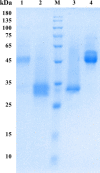Synergistic effect of acetyl xylan esterase from Talaromyces leycettanus JCM12802 and xylanase from Neocallimastix patriciarum achieved by introducing carbohydrate-binding module-1
- PMID: 30694400
- PMCID: PMC6351639
- DOI: 10.1186/s13568-019-0740-6
Synergistic effect of acetyl xylan esterase from Talaromyces leycettanus JCM12802 and xylanase from Neocallimastix patriciarum achieved by introducing carbohydrate-binding module-1
Abstract
Wheat bran is an effective raw material for preparation xylooligosaccharides; however, current research mainly focuses on alkali extraction and enzymatic hydrolysis methods. Since ester bonds are destroyed during the alkali extraction process, xylanase and arabinofuranosidase are mainly used to hydrolyze xylooligosaccharides. However, alkali extraction costs are very high, and the method also causes pollution. Therefore, this study focuses on elucidating a method to efficiently and directly degrade destarched wheat bran. First, an acidic acetyl xylan esterase (AXE) containing a carbohydrate-binding module-1 (CBM1) domain was cloned from Talaromyces leycettanus JCM12802 and successfully expressed in Pichia pastoris. Characterization showed that the full-length acetyl xylan esterase AXE + CBM1 was similar toe uncovered AXE with an optimum temperature and pH of 55 °C and 6.5, respectively. Testing the acetyl xylan esterase and xylanase derived from Neocallimastix patriciarum in a starch-free wheat bran cooperative experiment revealed that AXE + CBM1 and AXE produced 29% and 16% reducing sugars respectively, compared to when only NPXYN11 was used. In addition, introduced the CBM1 domain into NPXYN11, and the results indicated that the CBM1 domain showed little effect on NPXYN11 properties. Finally, the systematically synergistic effects between acetyl xylan esterase and xylanase with/without the CBM1 domain demonstrated that the combined ratio of AXE + CBM1 coming in first and NPXYN11 + CBM1 s increased reducing sugars by almost 35% with AXE and NPXYN11. Furthermore, each component's proportion remained the same with respect to xylooligosaccharides, with the largest proportion (86%) containing of 49% xylobiose and 37% xylotriose.
Keywords: Acetyl xylan esterase; CBM1 domain; Synergistic effect; Xylanase; Xylooligosaccharides.
Figures




References
-
- Antoine C, Peyron S, Lullien-Pellerin V, Abecassis J, Rouau X. Wheat bran tissue fractionation using biochemical markers. J Cereal Sci. 2004;39(3):387–393. doi: 10.1016/j.jcs.2004.02.001. - DOI
Grants and funding
LinkOut - more resources
Full Text Sources

